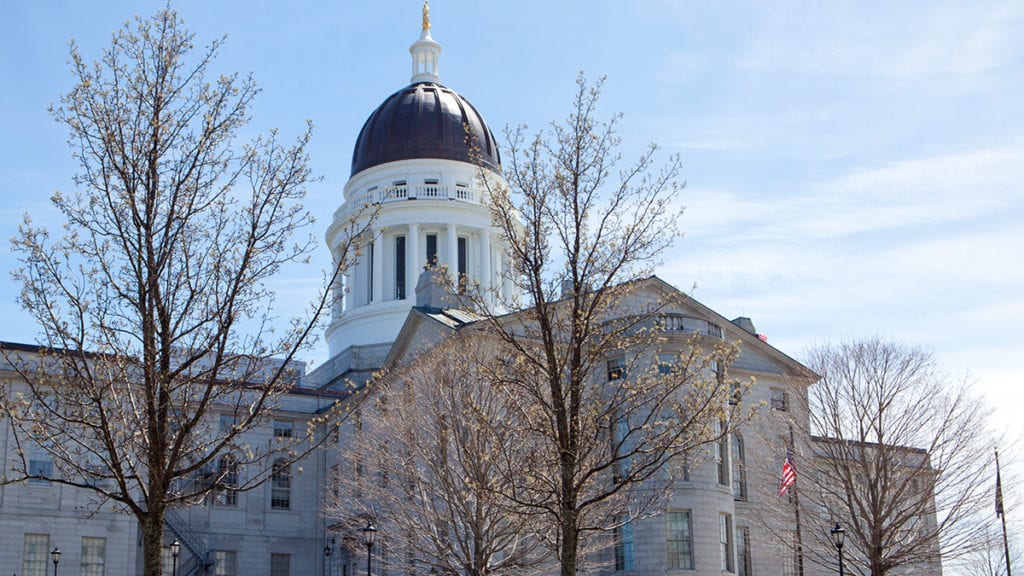
It’s an exciting time in Augusta. A new administration and new legislature means new opportunity. For the first time, Maine is being led by a Governor who campaigned on tackling climate change. We are committed to seizing this moment with bold action, promoting legislative and administrative actions to combat the greatest threat to Maine’s wildlife and habitat.
This session, alongside our allies in the Environmental Priorities Coalition, Maine Audubon will work to chart a new direction for Maine that includes:
- Getting Maine’s renewable energy economy back on track.
- Setting high-level commitments to reduce carbon pollution, while creating jobs and lowering energy costs.
- Supporting clean energy solutions at the community level.
Opportunities extend beyond climate and energy policy too. With new leadership at state agencies responsible for overseeing our natural resources, we can engage in open conversation about:
- Promoting siting of renewable energy infrastructure that limits impacts on high value wildlife and habitat.
- Improving management of our public lands.
- Exploring opportunities to better protect endangered species and their habitats.
This is an exciting moment, but make no mistake: we will face challenges. Rest assured that Maine Audubon will be in Augusta as much as ever, advocating for the interests of Maine’s wildlife and habitat.
As always, we’ll need your help. Be sure you’re part of our Action Network to stay up-to-date on news from the State House. Better yet, get to know your legislators personally. There are many new faces in Augusta, and they will benefit from getting to know more of their constituents and understanding the values they hold. Together, we’ll ensure Maine’s wildlife thrives.
Priority Spotlight: Strengthening Maine’s Endangered Species Act
Did you know that Maine has its own Endangered Species Act? The Maine Legislature established the Maine Endangered Species Act (MESA) in 1975 in response to concerns that species of fish and wildlife were in danger of disappearing from the state. There are currently 22 inland fish and wildlife species listed as endangered and 23 listed as threatened under the MESA, some of which are also listed under the U.S. Endangered Species Act (ESA). Listed species include the Blanding’s Turtle, Little Brown Bat, Upland Sandpiper, and Piping Plover.
The federal ESA is under attack. As a backstop to potential rollbacks, we will advocate for strengthening Maine’s Endangered Species Act. Maine has a strong history of picking up the federal government’s slack on environmental protections. We will work to protect wildlife in danger of becoming extinct in Maine, while continuing to advocate at the federal level against efforts to undermine our nation’s most successful environmental law.
 Climate & Energy
Climate & Energy
As the rest of the world races to reduce their carbon emissions, the United States is trailing behind. Maine needs to do its part to avert increasingly severe disruptions to both the natural and built environment by updating and strengthening its commitment to reducing carbon pollution. Maine Audubon will advocate for a comprehensive statewide strategy to transition to a low-carbon economy, as well as for policies that ensure we hit our carbon pollution targets in a timely way.
 Land & Water
Land & Water
Nonpoint source pollution, such as sediment from erosion, nutrients from fertilizer, and bacteria from septic systems, has a major impact on Maine’s waterways. Maine’s wildlife needs clean, clear water, and proper infrastructure can help keep it that way. We will advocate for funding for road engineers, contractors and public works crews to repair roadways, putting money in the pockets of Maine people and protecting wildlife.
 Habitat Connectivity
Habitat Connectivity
Land for Maine’s Future is a 30-year success story, catalyzing the conservation of over 600,000 acres of working forests, farms, and waterfronts. Today, the program is nearly out of funding. This legislative session, Maine Audubon will work to secure at least $75 million in new funding for LMF. New projects will help conserve habitat for wildlife to flourish throughout their life cycle and provide opportunities for outdoor recreation, while generating millions in revenue from our outdoor and natural resource economies.
 Wildlife Stewardship
Wildlife Stewardship
Maine’s Public Reserved Lands contain some of the largest, oldest trees in the state – prime habitat for boreal and migratory forest birds of high conservation value. By statute, management of these approximately 600,000 acres of land scattered across Maine must be equally balanced between sustainable forestry, outdoor recreation, and wildlife habitat. In recent years, this balance has been lost. Maine Audubon will work to rebuild the core functions of the Bureau of Parks and Lands with a sharp focus on conserving older forests.
Coming Soon: A New Report on Transitioning to Renewable Energy
Conservation Biologist and GIS Manager Sarah Haggerty and the rest of the Maine Audubon Conservation Team are putting the final touches on a report that recommends how Maine can transition to a clean energy future while protecting the state’s important ecological values. The report, derived from a sweeping literature review and GIS analysis, will contain best practices to reduce wildlife impacts from solar, on- and offshore wind, and transmission lines. Maine Audubon will use this report to guide policy and permitting decision-making as Maine charts its course to a renewable energy future.
Will you be a part of this work?
Be sure you are signed up to receive our Action Alerts so we can keep you apprised of all you can do to support Maine’s wildlife and habitat.
